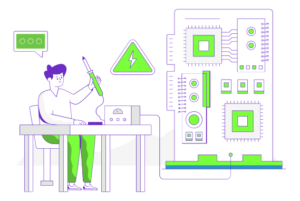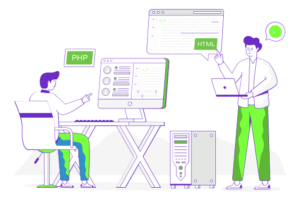Introduction
Finding a software development team is like finding the right doctor: it's critical to do your research and get a good sense of what you're going to get before you sign up for it. So, before you hire a dev shop or agency, make sure you understand how the discovery process works and what differentiates one team from another. Let's take it from the top…
What is the Discovery Process?
The discovery process is an iterative, collaborative, and data-driven method of understanding the problem that needs to be solved. It involves gathering information about your users, their workflows and environment, as well as the current state of any software solutions that might already exist.
This can be done through interviews with stakeholders and customers; observation of users in their natural habitat; conducting surveys or questionnaires; reviewing old documentation like manuals or emails; analyzing usage patterns on existing systems (if they exist); asking questions on social media channels such as Twitter and Facebook; looking at analytics logs from existing systems (if they exist). The goal is to get a clear picture of what's going on before you start making decisions about which direction(s) you should go next--and this information will be used throughout your entire product development cycle because it will inform all subsequent stages: prototyping ideas into working prototypes/mockups for testing purposes; building out those ideas into full products ready for release onto production servers!
Why does it matter?

Discovery is a process that helps you understand the problem you are trying to solve. It's important because it helps you define requirements and scope, which can be difficult when starting out on new software projects.
You might be wondering: if I'm building a new feature for my product or service, why do I need discovery? Well, first off--because it's important! Discovery helps ensure that your team understands what users really want and need from their products or services in order to deliver solutions that meet those needs effectively; without this understanding, there will likely be gaps between what users expect from us versus what we actually deliver (or worse yet--no solution at all).
How does discovery work?
The discovery process is a conversation. It's an iterative process that involves stakeholders, requirements, and prototypes.
The first step of the discovery process is to talk with your client about what they want their product or service to do and find a solution to the problem they are trying to solve. You'll need to get the requirements from them so you can create wireframes (a visual representation of how all this will work).
You then meet with your team members and discuss these wireframes together, making changes until everyone agrees on them before moving on to user research. At this point you'll have a better idea of who your users are and what they need from your product or service - so now it's time for prototypes!
What should I expect from a discovery process?
The discovery process is a collaborative, iterative, and learning-focused process. It's a series of conversations and activities that help you understand your users, their needs, and how best to serve them. You'll be able to ask questions like "Who are my users?", "What are the problems they face?" and "How can I solve those problems?". You'll also learn how to gather insights into your user base - what they do on a daily basis, where they go online (and offline), and what their preferences are when it comes to products or services like yours.
You should expect your software discovery to include several distinct phases, including:
- Analysis of the current state of your business and the needs of your users. This includes a review of existing applications, data sources, and processes.
- Analysis of the user experience, including how users access information and interact with your organization's systems.
- Research the market (competitors, emerging technology trends) to understand where you fit in and what opportunities exist for your organization to grow.
- Identification of key stakeholders (including end users) who will be involved in the project from start to finish.
Discovery is an important first step in building new software, so make sure you understand what it is and how it works.
Discovery is a process that helps you understand what your users need, how they use the product, and what they want from it. It's not just about understanding the problem; it's also about understanding your users.
It's important because it helps you make decisions about the product and keeps you focused as you move forward in building out new features or iterating on existing ones.
How we at Codelation approach Discovery.

At my prior firm, Codelation, we know how important it is to get off on the right foot when working with you. We believe in a collaborative approach to product development. That's why we make sure to always start our projects with a discovery kickoff where we introduce stakeholders to their discovery team, go over how often we'll meet, what our schedule is like, and what kind of expectations you should have of us as we work through your project.
Next is the solutions and custom values analysis. This involves extracting client needs via business analyst interviews and establishing custom solution values. We start with the question "What problems do we have the opportunity to solve?"
- Who is going to be ultimately using this product?
- Are there any compliance or regulatory issues that need to be taken into account?
- Are there any features that are absolutely non-negotiable?
This helps us understand what's important for you and what your expectations are for the product we'll be designing together. We'll also define values around your project that are most important to you. Defined values for your custom application. Scalable, maintainable, cost-effective, secure, etc. These should be prioritized based on your product and organizational needs.
Once we've got those things established, we move on to wireframing. We use this time to create 2-3 high-level mockups based on the requirements from solutions & custom values analysis. This helps us get an idea of what direction we should take with the design process going forward so that it meets our client's needs as much as possible!
After wireframing is done and reviewed by stakeholders, we define your MVP—Minimum Viable Product. Basically, it means that after Codelation has had its chance at defining an MVP with you, only certain features will be included in the scope. The MVP will be a subset of the remaining scope that was not included in this iteration. We'll also prioritize our backlog. This will be our future product backlog.
Now that there is a clear direction for where the project is going, we take the requirements, expected schedule, and ballpark budget you've given us and use them to form 1-3 project options. We want to make sure we're getting your input each and every step of the way, so we'll go over these in great detail before moving on to the next phase.
Once we've got our options together, it's time to present them to you. During this meeting, we'll take some time to review each option and answer any questions you may have about the presented options. This meeting is important because it gives you a last chance to make any final callouts about the scope and requirements of your project. Once we've reviewed all of these things together, we'll give our recommendation for which option is best for your needs.
We're here to help you come up with a plan that works for you, and we'll use our expertise to guide you through the discovery process so that you can make an informed decision about the direction of your project. After finalizing our recommendation, we'll sign off on a statement of work (SOW) and pick a date to start developing your project!
Our entire discovery process takes between 6-8 weeks and returns incredible deliverables and an understanding of what your product could be…
Let's recap.

Discovery is an important first step in building new software, so make sure you understand what it is and how it works. The discovery process involves gathering information about your needs and goals from stakeholders, users, business owners, and other stakeholders who will be involved with the project. This information helps define what success looks like for your project before any development begins so that everyone involved agrees on what needs to be built or changed before working on anything else.
Is there a new project your company is looking to build? Or a feature update that one of your products needs? We're ready to partner with you. Start your Discovery with Codelation!